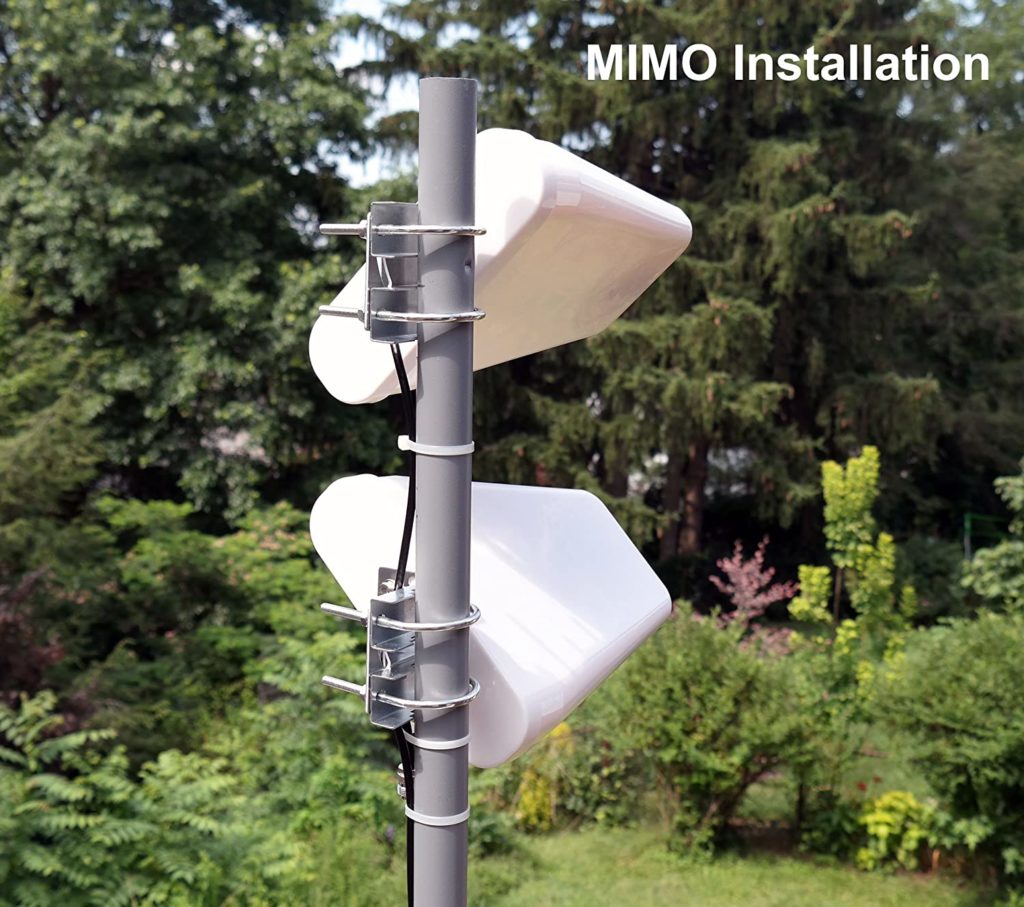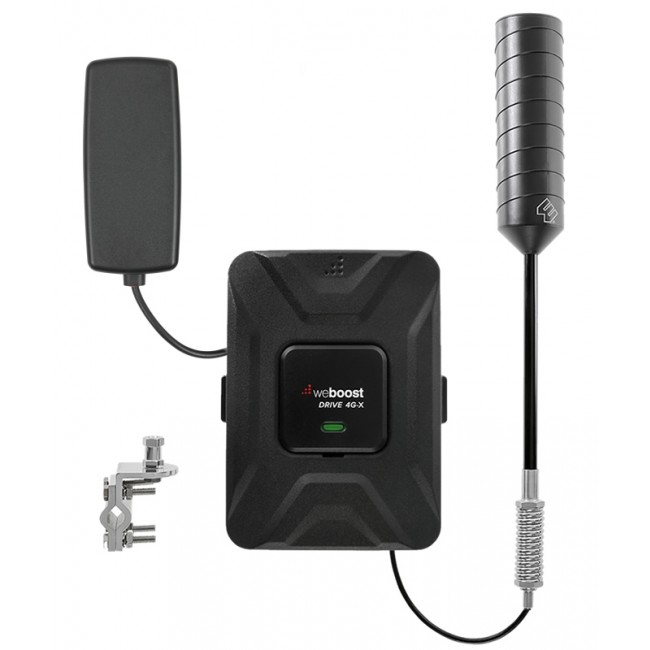You can boost your cell signal when camping by either (1) using a cellular antenna, or (2) using a cellular booster. Both can yield similar results, though the former, the antenna, is often cheaper. Technically, the latter, the booster, works better in most situations. However, each has their advantages and disadvantages when it comes boosting cell signal.

How to Boost Your Cell Signal When Camping
Getting good Internet access while camping is becoming more important for many boondockers. Cellular antennas and cellular boosters are equally as effective, though each has its advantages in varying situations.
Cellular boosters are effective in places with weak to average cell signal strength. But in places where signal is average to excellent, they actually make your signal worse.
Cellular antennas are effective in places with fair to excellent signal strength. They don’t seem to work very well at all where signal is weak.
Both cellular boosters and antennas do not work at all where there is no signal.
Cost of a Cellular Booster Versus Antenna
Cellular booster kits offered by Winegard and WeBoost can cost between $500.00 to $750.00. These kits include the necessary cables, mounts, and poles.
By contrast, a good cellular antenna can run between $100.00 to $150.00. However, you have to buy the cables, mounts, and poles separately. The total cost of everything needed may range from $150.00 to $250.00.
Note that cellular antennas use a cable that plugs into a hotspot device or router to work properly. Both devices require a SIM card from your cellular provider. This means having to add another line (phone number) to your cellular service. By contrast, cellular boosters do not require adding another line. It will work with all the cellular devices you already have (phone, tablet, smartwatch, etc).
How Cellular Antennas Work
Cellular antennas work by capturing as much cell signal as possible and funneling into a hotspot or router. Most boondockers use hotspot devices as their routers. These antennas typically require two wires, one for outgoing signal and the other for incoming. Cellular antennas designed for 4G networks are capable of capturing signals in a wide of variety of frequencies, hence the acronym “MIMO” (multiple-in, multiple-out).
This is why you will need a hotspot device or router with two antenna ports, one for outgoing signal and the other for incoming. Hotspots and routers with no antenna ports will not work with an antenna.
Many boondocking geeks prefer to use a router instead of a hotspot device. Routers made by Peplink are the most popular. They function just like a hotspot device. They have a slot for a SIM card which you will need to use your cellular service with. They also have MIMO antenna ports. Once everything is in place, your phone, tablet, even your television will connect to it wirelessly.
The best antennas are directional antennas. These are intended to be turned towards the nearest cell tower. Because of this, these antennas can only be erected while parked or camping. If you need an antenna while driving down the road, you will need an omni-directional antenna. These are intended to be mounted securely to a vehicle, and will capture cell signal from any direction. Directional antennas, however, do a much better job at capturing signal.
Yagi antennas are the most effective of directional antennas. These involve two separate antenna units, one for outgoing signal, and one for incoming signal. One of the antennas has to be turned and mounted at a 90-degree angle from the other antenna to avoid feedback loop (see photo). Yagi antennas are usually sold one a-piece, and each can be used either for incoming or outgoing cell signal.
Most antennas offers anywhere from a 5 decibel gain to 15 decibel gain.
The higher you raise an antenna into the air, the more signal you can capture. Hence, it’s best to mount the antenna units on a long, metal pole.
It’s also best to create an electrical ground for the antenna. This improves the strength of the cell signal. This means mounting the antenna to a metal pole, and then mounting the pole into the Earth itself. Or, you can connect a ground spike to the pole. If you cannot do either of these, then at least connect the antenna to the metal chassis of your RV.
How Cellular Boosters Work

A cellular booster simply increases the volume of the cell signal so that your phone, tablet, and hotspot device can “hear it better”. Cell phone signals are audio signals that run at too high of a frequency to be heard by the human ear. Cellular boosters literally make these sounds louder.
As a result, cellular boosters also increase the noise. If there is too much static noise in the signal, your device will continue to re-request the same packets of data from the sender until it finally gets a clean packet. This could result in slow service. If you’re camping in an area with average to excellent cell signal, then a booster will actually slow down your service due to increased noise. In that case, it’s best to shut off your booster. Antennas, on the other hand, do not increase noise.
A cellular booster uses an outside antenna to connect to a cell tower, and funnels that signal into a boosting unit. The boosting unit then increases the volume of the signal, and sends it to an inside antenna. Your phone, tablet, and hotspot, will connect to this inside antenna. The outside antenna and the inside antenna usually have to be 8 feet apart to minimize feedback.
Boosters also require electricity to operate. Booster kits offered by Winegard and WeBoost come with stadard 110-120 volt plug to plug into a wall outlet, and usually have a 12v hardwire option as well.
Most cellular boosters advertise a 50 decibel gain to a 65 decibel gain.
Which is Better, Antennas or Boosters?
- Boosters work better in places with weak signal. Antennas can also work in areas with weak cell signal, but work even better in areas with moderate to excellent signal.
- Boosters should be turned off when camped in places with good to excellent signal to avoid boosting noise. Antennas, however, can be utilized anywhere.
- Antennas do not require any power to function. Boosters, however, have to be connected to a power source.
- Antennas can cost between $150 to $250 when you include the cost of the pole, mounting hardware, coaxial cable, and connectors. Boosters can cost between $500 to $750, but usually come with everything you need to mount and install.
- Boosters can be left mounted to the RV or vehicle while driving. Antennas can also be left mounted while driving, depending on how tall the pole is. Generally you want a taller pole for antennas, but must take it down while driving.
If you want to get geeky with improving your cellphone signal, go with an antenna. There are far more choices in antennas, routers, poles, low-loss coaxial cable, grounding solutions. Signal boosters generally are limited to self-contained units that don’t offer much flexibility in customization.
If you want something already configured with easy installation, get a signal booster. You get everything you need in one box, and generally works for most camping situations.
Which Brand of Antenna or Signal Booster Should I Get?
Antennas – Proxicast is the leader in cellphone signal antennas. Amazon sells lots of Proxicast stuff.
Signal Boosters – WeBoost (Wilson Electronics) is the leader in signal boosters. Winegard is another brand that’s catching up to WeBoost. We recommend sticking with these two brands because Amazon is flooded with worthless Chinese signal boosters.


Installed SureCall in our ERA Sprinter van. We travel a great deal where in the past we had no cell service however after installing this unit we have not lost cell service. There are serval parts of rural Florida and several rural roads we travel on back and forth from Florida to Texas where we would have no cell service. This past December we traveled from Florida to Texas on back roads through very rural areas and our cell service never fell below 2 bars. In the past, on these same roads, we routinely lost cell coverage. This device will only boost signal that is already there. If you are in an area where there is no available signal because the lack of cell tower coverage, this device will not help. Again, it only increases any weak signal that might be available.
I purchased weBoost in 2018 for our RV (we are full-timers) and have been very happy with its performance. We use Verizon and tend to travel to places that are “off the grid”. We are almost always able to boost any existing signal and often times we can even get it to go from “no service” to at least enough to send and receive texts. BUT the main reason I am writing this review is to give Wilson Electronics (home of WeBoost) a very deserved pat on the back and a huge thumbs up. Sometime in September, I managed to drag a tree branch over the external antenna and knocked the cover loose – it still worked but the next time we drove down a paved road it blew off and we were left with a bare antenna. STILL worked. I called Wilson Electronics and asked if I could purchase a new cover. They informed me that they would replace it as a customer courtesy and apologized for that because of Covid they would have to ship it FedEx ground. That was okay with me. I was just pleased to be getting a replacement cover. WELL! The “cover” arrived three days later – USPS priority and wasn’t a cover it was a completely new outside antenna!
After doing a ton of research on the various boosters available in your article, I opted for the Cel-Fi Go X system. I installed the Go X system yesterday and couldn’t be more pleased.
I want to be able to connect to cellular service while out hiking away from my vehicle. Does a signal booster provide this function? If so, why would the boosted signal antenna be mounted inside the vehicle? Confused.